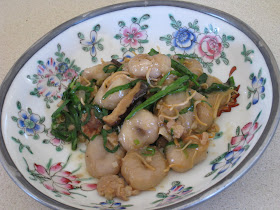

I love anything cooked with taro and this dish is one of my favorites, perhaps it's in my genes . This traditional Hakka dish is eaten during festive celebrations such as Chinese New Year, Dragon Boat Festival and the Mid-Autumn Festival for prosperity. sueen poon chee, or abacus seeds, are springy discs of yam, shaped after its namesake. I have tried many times trying to get the springiness by adjusting the ratio of yam to tapioca starch. I like more springy and have to sacrifice the taste of yam by using more tapioca starch. For this dish, the ingredients cooked with this abacus seeds have to be very flavorful.
Ingredients:
Ingredients:
1 lb taro, cleaned, peeled and thinly sliced(i used frozen ones, thaw and slice)
12 ozs tapioca starch
3 tbsp cooking oil
5 cloves garlic, peeled and sliced
1/4 cup dried shrimp, soak and coarsely chopped
11/4 cup shredded dried squid - soak
6 dried Chinese mushroom, soaked till soft and sliced
1/2 lb ground pork
1/4 lb chinese chives - cut into 1 inch in length
1 tsp pepper
1 tsp fish sauce
1 tsp oyster sauce
1/2 cup chicken stock
Method:
Steam taro until soft and mash.
Place the tapioca starch in a large mixing bowl and add hot taro paste to it, stirring it in well
When the taro and starch mixture has cooled , knead it to form a dough.
Pinch off enough dough to roll into a ball , 1 inch in diameter. Press the ball between your thumb and forefinger so that it is depressed in the middle and shaped like an abacus seed.
Repeat until dough is used up.
Fill a pot with water to the three-quarter mark and bring it to a boil.
Place abacus seeds in the pot and cook, stirring occasionally to prevent the seeds from sticking to the bottom of the pot. When cooked, the seeds will float to the top. Scoop out the cooked abacus seeds and leave them aside to drain.
To a hot wok, add 2 tbsp oil and fry the garlic till golden brown before adding dried shrimp, shredded dried squid and mushroom. Stir fry the mixture , then set aside.
Add the remaining tbsp oil to the hot wok and fry the ground pork until it is cooked and no more pink.
Add in the cooked garlic, dried shrimp, shredded dried squid, mushroom, abacus seeds and the seasonings.
Add in the chinese chives and stir briefly.
Dish out and sprinkle with sesame oil.
Serve hot.


Hey Lily,
ReplyDeleteThis is one of my favourites. I'm Hakka and I've always remembered my grandma making this dish. However, in our family, we use just minced pork, not the dried shrimp and dried squid and we also don't add chives. We use shredded wood ears (mok yee) instead for the crunch. Now I live in NZ and the problem I find is that it is hard to find good floury taro. When they are not floury, you can't mash them up well and they have little lumps which are not pleasant.
anonymous
ReplyDeletei know what you mean about getting good taro, it is frustrating, pay alot and get a very hard one. I use the frozen ones which are the best that i can get here.
Loads to learn, whenever I come to visit you and that is what makes it so interesting.
ReplyDeleteI have a Chinese friend too, and I have learnt a few things with her.
All my love
My parent are Hakka, my mom used to fry this dish.
ReplyDeleteWe add in wood ears, bean sprouts and minced meat and most Hakka dishes have Chives & fish sauce. This is a MUST in this dish and dried Hakka noodle too. We blanch the beans sprout before we add into any dishes so that it will taste better, even for the Ipoh Sar Hor Fun, as most of the people in Ipoh are Hakka, fish sauce is added to most of the dishes without fail and it is a secret of most of the hawkers food too.
I noticed that your chives are very long. We used to cut them into 1-2 inches long.Otherwise 1/2 in your mouth and 1/2 in your throat !
rebecca
ReplyDeletethe chives are cut short usually, i know what you mean.
thanks for dropping by